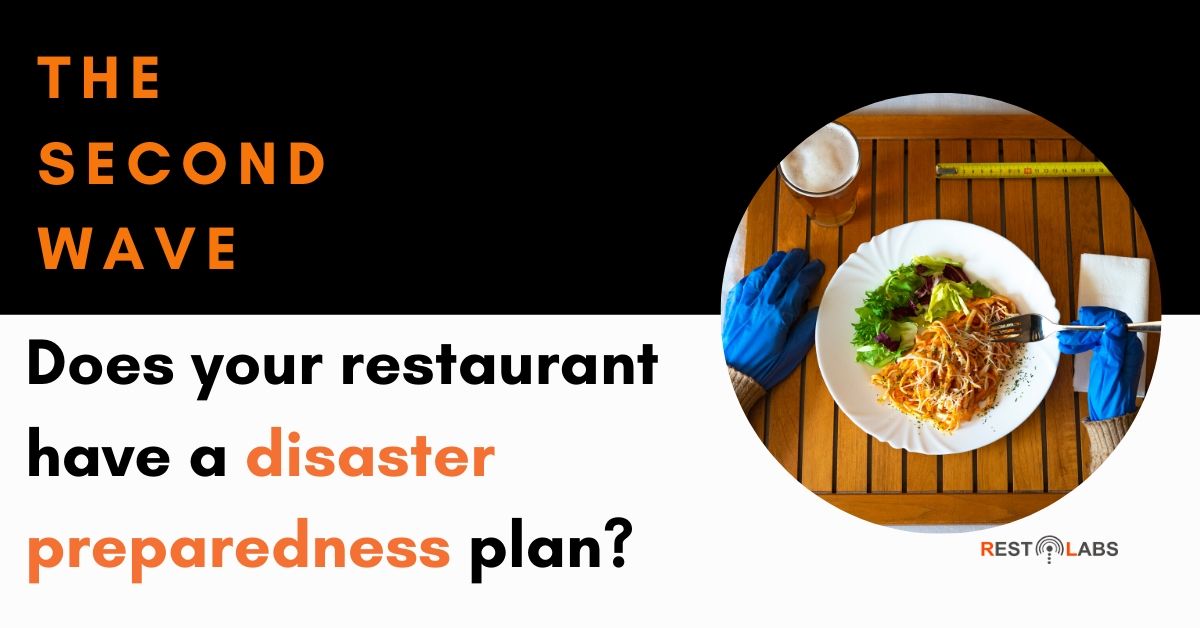Key Takeaways
As we emerge from the first wave of the pandemic, it's clear that the industry wasn't prepared for a major shift like this. But nature has its own way of communicating its concerns with humankind, leading to all sorts of disasters - many a time wreaking havoc that enforces us to go back to the drawing board.
If we go by the predictions of the market experts, the second wave of coronavirus is just around the corner, and not long from now, the restaurant industry will be witnessing another major set back.
The unexpected happens, or else Murphy's Law wouldn't exist. With the second wave of Covid-19, it's not a question of "IF", but "When" and "How Devastating".
It's time to prepare for the war that’s yet to be announced. But how?
In this article, we’ll explore a five-step disaster preparedness plan that should help your restaurant render the impedance and spring back into shape:
Step 1: Address the Issues
You’ve already survived the first wave of the pandemic and this experience gives you the edge over those who’re still struggling to go by the day. The second wave may not be a lot different than the first one. The only difference would be that this time you’d be aware of all the challenges that you faced initially, and better prepare yourself and your staff to manage those.
Make a list of all the challenges that you had to face and start taking action accordingly.
For instance, if procuring fresh vegetables, mainly salads, was the most challenging part of operations, then the optimal solution would be to cut a deal with a local farmer to maintain a regular supply of fresh vegetables.
Alternatively, and if your budget allows, you can also get a hydroponics system installed in your kitchen to strengthen food security. Vertical farming practices enable you to grow salads, spicy herbs, berries, and vegetables in an urban environment with minimal cost.
Step 2: Get on top of the delivery game
The first wave must have directed your business towards online ordering and delivery. While most restaurants started listing themselves on the third-party aggregators’ websites as soon as the shut down was announced, many, after a certain point realized that having their own online ordering system would be more beneficial.
But the major challenge was to put together a delivery fleet, and, we all know that it’s not an easy feat.
There are a lot of factors that one needs to take into consideration to bring together a team of delivery professionals and a tracking process, albeit the whole chaos of the worldwide outbreak.
But we know for sure that having an in-house online ordering system is the only way to keep the business running, and profitable in the future. This also means that before the second wave, you must start hiring delivery drivers, mark your delivery zones as well as take into account state and safety regulations.
Alternatively, you can outsource or collaborate with last-mile delivery services like Postmates Fleet, Nuro, and Bringg, to expedite the process and widen the reach.
And if you are yet to launch your restaurant online, Restolabs can help you get online in just 3 days. Schedule your Free Live Demo with our team here.
Step 3: Stock up on safety essentials
Masks, disposable gloves, hand sanitizers, shoe covers, tamper-proof packaging - stock them up, you and your staff would need them to fight the second wave effectively, efficiently, and safely.
Don’t hoard them though, others need them as much as you do.
The best approach is to create a two-week cache as you’d for kitchen ingredients.
Another option is to buy reusable face masks or make your own with simple materials like elastic and HEPA vacuum filters.
You can also collaborate with a wholesaler or a manufacturing unit to get a better deal on your supplies. This should help you save a lot of money by the end of the day.
Step 4: Build an Emergency Fund
We don’t intend to spread fear, but the problem with a crisis is that you can’t predict when they will happen, how long they will last, or how badly you might be affected. Many scientists presume that there could be a third wave as well which means that you need to build an emergency fund to secure financial stability.
Even saving 10% per month from the restaurant’s profit can help build a reserve to dip into when emergencies come up. Treat this as a monthly expense. It’s highly recommended to set aside at least 6 to 8 months of operating expenses.
You must also assist your workers to take advantage of various funds created for restaurant worker impacted by the pandemic. Some of the most prominent ones are One Fair Wage Campaign, United States Bartenders Guild, and COVID-19 Emergency Relief Fund by Restaurant Worker’s Community Foundation.
Stay up to date on various grants by setting a Google Alert for terms like “coronavirus restaurant grants,” so the latest information can be delivered to your inbox.
Step 5: Reevaluate your terms of business
We are in the middle of a crisis and it’s paramount that we renegotiate the terms of business with our partners, as well as suppliers. In simple terms, it’s time to trim some of the fat!
Look for ways to cut down the expenses. You can start by reevaluating your terms of business with food and alcohol suppliers/distributors. For instance, if alcohol is moving faster than food, negotiate with the distributor to get faster supply. This also means that you can trim the menu consisting of only the most popular dishes. Such activity will help you cut down the inventory cost, as well as reduce the wastage.
On the other hand, if you have a line of credit with your vendors, see if they are offering flexible options, including a reduction in your interest rate or increasing the payment window. Most contracts have a “force majeure” clause that can give you some temporary relief from the contractual obligations during the crisis.
Plan Ahead!
Coronavirus has impacted our lives in ways that no one could predict. But it taught a pivotal lesson and that’s to evolve to adapt to the new ways of life. The second wave of the infection is certain and it’s only a matter of time that the government reintroduces the state of emergency.
It’s time to accept the urgency of planning and these five steps will help you keep the business operational during the challenging times ahead. Distinguish yourself from your competitors by taking quick and strategic action.
Are you taking the necessary steps to prepare for the second wave of COVID-19? What are you doing?
Frequently Asked Questions


.gif)

.png)






